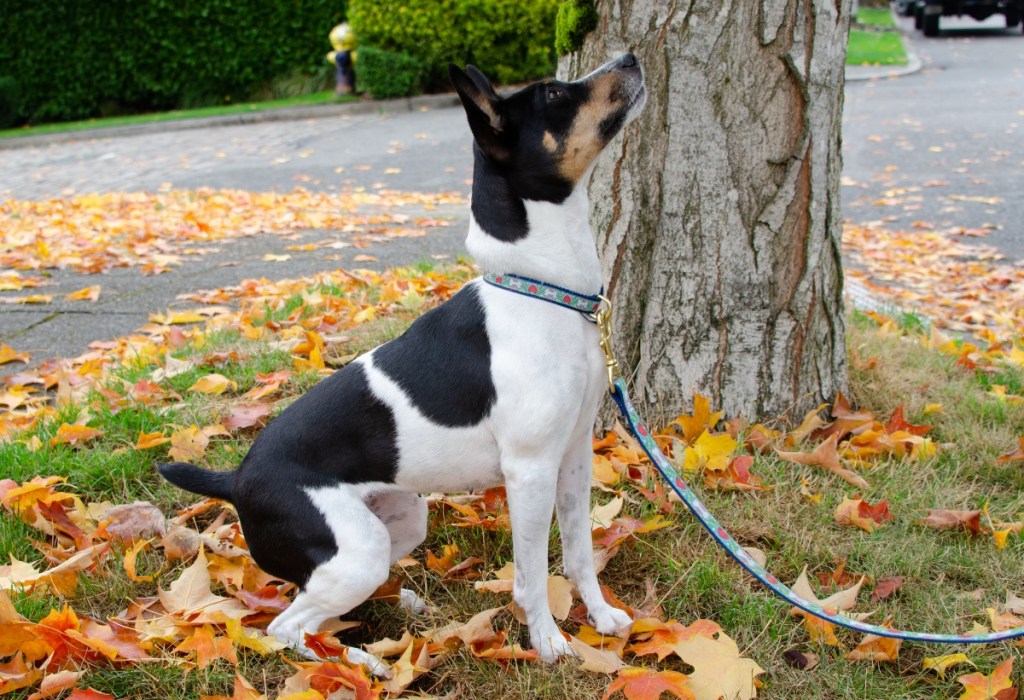Table of Contents
Introduction to Rat Terriers
One of the many types of terriers is the rat terrier, a curious and lovable dog that comes in two official sizes. There are standard and miniature rat terriers, and both varieties have an elegant look, happy-go-lucky attitude, and versatile demeanor. Originally bred to hunt small animals, rat terriers are popular household pets that are highly trainable and excellent companions.
In this Healthy Paws dog breed guide, you’ll learn all about the rat terrier breed, including their physical characteristics, typical behaviors, and how to take the best care of their health.
Size of Rat Terriers
Rat terriers typically weigh between 10 and 25 pounds, depending on whether they are miniature or standard. Miniature rat terriers stand 10 to 13 inches tall, and standard rat terriers are 13 to 18 inches tall. Some breeders have created toy rat terriers that are smaller, weighing just 5 to 10 pounds, although this variation is not recognized by the American Kennel Club (AKC). All rat terriers are considered fully grown by at least 12 months of age.
Dogs of this breed are in the puppy stage until three months of age and go through puberty from age three months to nine months. Male and female rat terriers mature at different rates, and dog researchers have found that males tend to be less prone to stress, while females may learn new tricks more quickly.
Characteristics of Rat Terriers
Rat terriers are compact, smooth-coated dogs that are tough and playful. They are fun to be around and love a hardy day of work or play. These dogs excel at canine sports and make excellent watchdogs. However, rat terriers love to dig and chase, and they aren’t as people-pleasing as other types of dogs. Rat terriers are generally great with older children, although they may be too rowdy for younger kids. These dogs are also easy to groom.
As you get to know a rat terrier’s personality, here’s what you can expect based on the breed characteristics:
| Breed Characteristic | Level (High, Medium, Low) |
| Affectionate with People | Medium |
| Good with Kids | Medium |
| Good with Pets | Medium |
| Need for Exercise | High |
| Energy Level | High |
| Intelligence Level | Medium |
| Able to Be Trained | High |
| Amount of Barking | Medium |
| Amount of Shedding | Medium |
History of Rat Terriers
Rat terriers were originally bred in America, and some historical records indicate that President Theodore Roosevelt chose their name. As their name suggests, these dogs were bred to kill rats. This was an essential job on farms in the early 1900s, where rodent infestations could deplete grain supplies and put farmers out of business. Rat terriers have also been used to hunt other animals, serve as watchdogs, guard henhouses, and entertain children.
The rat terrier breed resulted from mixing bull terriers, fox terriers, Manchester terriers, and Old English white terriers. Some people have also bred rat terriers with Italian greyhounds and Whippets to hunt jackrabbits. They were also bred with beagles to create pack-oriented dogs. A breeder named Milton Decker created the Decker rat terrier to be larger than standard rat terriers and excel in water retrieval and other versatile hunting skills. A hairless rat terrier was born in 1972, which led to the development of the American hairless terrier. The American Kennel Club first recognized the rat terrier breed in 2013.

Rat Terrier Standard Information
The American Kennel Club has published breed standard information for the rat terrier to describe the ideal characteristics for this multipurpose companion dog capable of hunting small game. The description details how the dog should be sturdy, compact, and small-to-medium sized.
Here is an overview of the breed standard information for rat terriers:
Head:
- Smooth, blunt wedge-shaped head
- Intelligent, alert expression
- Eyes are small and set wide apart
- Ears are set on the top outer edge of the skull
- Skull is moderate in width
- Muzzle is strong and shorter than the skull
- Nose color corresponds with body color
- A couple of broken teeth or scars are not faulted

Neck, Topline, Body:
- Neck length is proportional to the head
- Topline is smooth and blends from the back through the loin
- Body is compact, strong, and flexible
- Tail is usually docked between the second or third joint
- Tail can also be left naturally long or be a natural bobtail
Forequarters:
- Shoulder blades are well laid back
- Forelegs are straight and parallel
- Feet are oval-shaped
- Toes are compact and moderately arched
- Front dewclaws may be removed
Hindquarters:
- Hindquarters are muscular and balanced with forequarters
- Stifles are well bent with short hocks
- Hind feet are slightly smaller than front feet
- Rear dewclaws should be removed
Coat:
- Smooth, short, shiny, and short-lying coat
- Texture may be somewhat rough or wave along the back
- No kinks or curls
- Do not remove whiskers
Color:
- Any pied patterning variation is acceptable
- Large patches of one or more colors with white
Gait:
- Efficient, ground-covering trot with good reach and drive
- Legs converge toward the center line with increased speed
Caring for Rat Terriers
Rat terriers are adaptable and versatile dogs that do well with apartment lifestyles. They fare better in warmer climates than colder ones and have high energy needs. They’re easy to groom, easy to train, and love to play more than anything else.
Here are some general tips for taking the best care of a rat terrier:
Best Living Environments:
- Excellent farm dogs
- Well-suited for apartments
- Homes with backyards are ideal to run around and dig
- However, their small size makes them suitable for seniors and city living
Type of Exercise:
- Playtime in a fenced backyard
- Roaming around a farm or yard
Mental Enrichment:
- Following family members around the house and yard
- Playtime with children
- Interactive dog toys
- Dog sports and agility training
Training Strategies:
- Generally easy to train
- Use rewards and games for training
- Crate-train your dog to prevent unwanted chewing
Grooming Tips:
- Low-maintenance grooming needs
- Brush once per week
- Bathe every four to six weeks
- Use a rubber curry brush for seasonal shedding twice per year
Common Health Problems of Rat Terriers
The average life expectancy of a rat terrier can vary greatly depending on the dog’s size, health conditions, and care. Most of these dogs live between 12 and 18 years. To ensure that puppies are healthy, breeders should provide health clearances for elbow dysplasia, hip dysplasia, von Willebrand’s disease, hypothyroidism, thrombopathia, and eye diseases.
These are some of the most common health issues that arise with rat terriers:
- Patellar luxation
- Legg-Calve-Perthes disease (a disorder of the hip)
- Hip dysplasia
- Misaligned jaw structure
- Allergies
- Demodectic mange
- Heart disease

Diet and Nutrition for Rat Terriers
Most rat terriers will need to eat ½ to 1 cup of food per day, although your dog’s ideal food intake will depend on their size and the caloric density of your dog food.
These high-spirited, energetic dogs can become underweight because of their activity level. To overcome this issue, some pet parents let their adult rat terriers free-feed with accessible food at all times of day. You might also try feeding your dog three times per day instead of two times. However, obesity can also be a concern in some rat terriers, so it’s important to monitor your dog’s weight closely and adjust their food intake as needed.
Where to Adopt or Purchase Rat Terriers
One resource to start with if you are interested in rat terriers is the Rat Terrier Club of America, which offers a listing of breeders by state on its website. You might also consider adopting a rat terrier needing a loving home through a rescue group, such as New Rattitude or Ratbone Rescues.
Related Breeds
If you are attracted to the size, temperament, and personality of rat terriers, you might also want to learn about similar and related breeds of dogs before deciding to purchase or adopt a new pet. Here are some other breeds to learn about:
- Parson Russell terrier
- Smooth fox terrier
- American hairless terrier
- Bull terrier
- Beagle
- Whippet
- Manchester terrier
Pet Insurance for Rat Terriers
One of the most important things you can do to protect your rat terrier long-term is enroll your dog in a pet health insurance plan with Healthy Paws. We offer rat terrier insurance that covers accidents, illnesses, cancer, emergency care, genetic and hereditary conditions, breed-specific conditions, and alternative care. We’ve had the top-rated pet health insurance plan for seven years in a row and have flexible premium and deductible options to match your budget and help you avoid having to pay exorbitant veterinary bills out-of-pocket.
Contact us today to learn more about insuring your rat terrier at any age and to get your rat terrier insurance quote.









